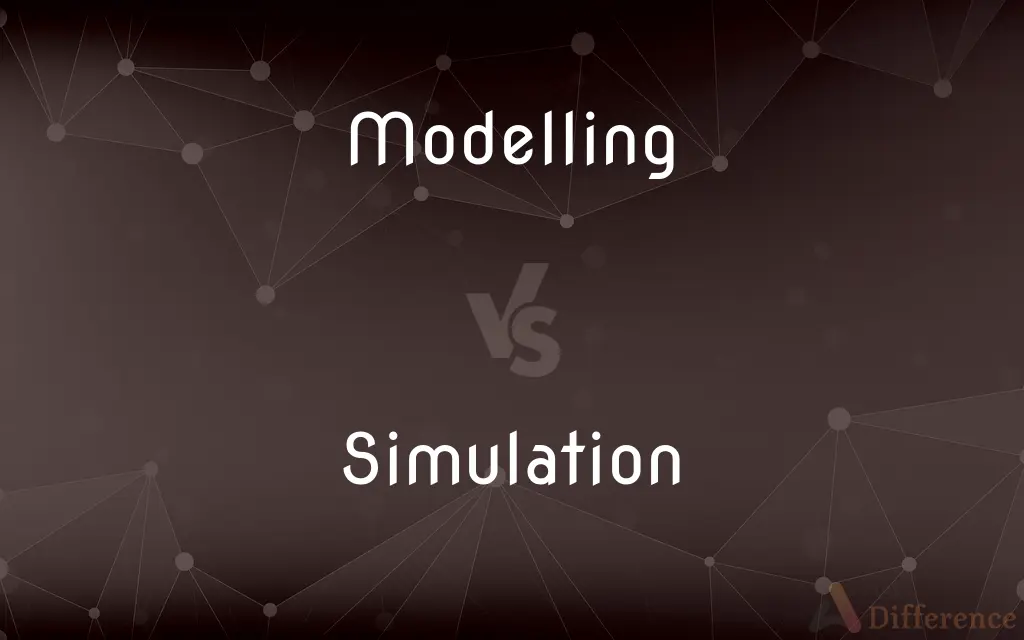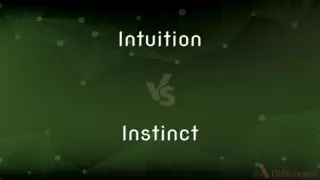Modelling vs. Simulation — What's the Difference?
By Urooj Arif & Fiza Rafique — Updated on April 15, 2024
Modelling involves creating a representation of a system or process, focusing on structure; simulation uses these models to predict behavior under different scenarios.

Difference Between Modelling and Simulation
Table of Contents
ADVERTISEMENT
Key Differences
Modelling is primarily about constructing a conceptual, mathematical, or physical representation of a real-world scenario or system. This could involve creating diagrams, software algorithms, or scale models to understand the structure or functioning of the subject. Whereas simulation takes these models and manipulates them to observe how they behave under various conditions or over time, often using computer software.
In the context of engineering, modelling is used to detail the components and interactions within a system, such as a machine or a building. It defines the parameters and boundaries of what is being studied. On the other hand, simulation applies these details to see how the system operates in different environments or stresses, such as simulating earthquake effects on a building.
Modelling is a crucial step in many scientific disciplines, providing a static framework from which dynamic behaviors can be studied. It often involves simplifying complex systems to their most essential elements. Simulation, on the other hand, introduces variables and parameters that mimic real-world conditions to test how a model behaves dynamically.
In business and economics, modelling might involve creating financial models to forecast the impacts of various strategic decisions. These models are then used in simulations to predict outcomes under different economic scenarios, helping in strategic planning and decision-making.
Education utilizes modelling to help students visualize abstract concepts by creating physical or virtual models. Simulations, however, are employed to provide interactive experiences where learners can manipulate variables and see the outcomes of their decisions, enhancing understanding and engagement.
ADVERTISEMENT
Comparison Chart
Purpose
To create a simplified representation of a system or process
To predict behavior of a model under various scenarios
Focus
Structure of the system
Behavior and dynamics of the system
Primary Uses
Conceptual understanding, design phase
Testing, prediction, training
Tools
Diagrams, mathematical formulas, physical replicas
Computer software, virtual environments
Dependency
Can exist without simulation
Requires a model to simulate
Compare with Definitions
Modelling
In software development, modelling refers to creating abstract models of software systems before coding.
Before writing the code, the team developed a model of the software architecture.
Simulation
In research, simulations help in predicting the outcomes of experiments before actual implementation.
Researchers conducted simulations to predict the spread of the virus under various public health policies.
Modelling
Financial modelling is used to forecast the financial performance of a company.
The analyst created a financial model to explore different investment scenarios.
Simulation
Simulation in video games involves games that mimic real-life activities.
The game features a detailed city-building simulation.
Modelling
In science, modelling often involves mathematical equations to represent physical phenomena.
The physicist developed a model to describe the motion of planets.
Simulation
Educational simulations are used to enhance learning through interactive experiences.
Students used a simulation to learn about the ecological impacts of pollution.
Modelling
The process of creating a representation of a complex real-world system in a simplified form.
A city planner uses modelling to create a scaled-down version of a new urban area.
Simulation
The use of a model to study the behavior of a system under various conditions.
The engineers used simulation to test the new engine design under high stress.
Modelling
Modelling can also mean the act of posing for photographs or art.
She went to the studio for a modelling session.
Simulation
In training, simulation refers to the creation of a life-like scenario that mimics real-life conditions.
Pilots undergo hours of simulation to prepare for actual flight conditions.
Modelling
The work of a fashion model
Have you ever thought of a career in modelling?
A modelling agency
Simulation
A simulation is the imitation of the operation of a real-world process or system over time. Simulations require the use of models; the model represents the key characteristics or behaviors of the selected system or process, whereas the simulation represents the evolution of the model over time.
Modelling
The activity of making three-dimensional models
Lessons included life drawing and clay modelling
Simulation
The act or process of simulating.
Modelling
The devising or use of abstract or mathematical models
Macroeconomic modelling and policy analysis
Simulation
An imitation; a sham.
Modelling
A small object, usually built to scale, that represents in detail another, often larger object.
Simulation
Assumption of a false appearance.
Modelling
A preliminary work or construction that serves as a plan from which a final product is to be made
A clay model ready for casting.
Simulation
Imitation or representation, as of a potential situation or in experimental testing.
Modelling
Such a work or construction used in testing or perfecting a final product
A test model of a solar-powered vehicle.
Simulation
Representation of the operation or features of one process or system through the use of another
Computer simulation of an in-flight emergency.
Modelling
A schematic description or representation of something, especially a system or phenomenon, that accounts for its properties and is used to study its characteristics
A model of generative grammar.
A model of an atom.
An economic model.
Simulation
Something that simulates a system or environment in order to predict actual behaviour.
This exercise is a simulation of actual battle conditions.
The most reliable simulation predicts that the hurricane will turn north.
Modelling
A style or design of an item
My car is last year's model.
Simulation
The process of simulating.
Despite extensive simulation in the design phase, the aircraft failed to behave as expected.
Modelling
One serving as an example to be imitated or compared
A model of decorum.
Simulation
(video game genre) A video game designed to convey a more or less realistic experience, as of a sport or warfare.
Some kids in the classroom will be playing simulations after school.
Modelling
One that serves as the subject for an artist, especially a person employed to pose for a painter, sculptor, or photographer.
Simulation
Assuming an appearance which is feigned, or not true.
Modelling
One that serves as the basis for a fictional character or place.
Simulation
(soccer) The act of falling over in order to be awarded a foul, when no foul has been committed.
Modelling
A person employed to display merchandise, such as clothing or cosmetics.
Simulation
The act of simulating, or assuming an appearance which is feigned, or not true; - distinguished from dissimulation, which disguises or conceals what is true.
Modelling
(Zoology) An animal whose appearance is copied by a mimic.
Simulation
(computer science) the technique of representing the real world by a computer program;
A simulation should imitate the internal processes and not merely the results of the thing being simulated
Modelling
Being, serving as, or used as a model.
Simulation
The act of imitating the behavior of some situation or some process by means of something suitably analogous (especially for the purpose of study or personnel training)
Modelling
Worthy of imitation
A model child.
Simulation
Representation of something (sometimes on a smaller scale)
Modelling
To make or construct a descriptive or representational model of
Computer programs that model climate change.
Simulation
The act of giving a false appearance;
His conformity was only pretending
Modelling
To plan, construct, or fashion in imitation of a model
Modeled his legal career after that of his mentor.
Modelling
To make by shaping a plastic substance
Modeled a bust from clay.
Modelling
To form (clay, for example) into a shape.
Modelling
To display by wearing or posing in
Model clothes.
Modelling
In painting, drawing, and photography, to give a three-dimensional appearance to, as by shading or highlighting.
Modelling
To exhibit (a behavior) in such a way as to promote the establishment of similar patterns of behavior in another
The therapist modeled socially appropriate conversation.
Modelling
To repeat (a behavior observed in another)
The child was modeling her mother's nurturing behavior.
Modelling
To make a model.
Modelling
To work or serve as a model, as in wearing clothes for display or serving as the subject of an artist.
Modelling
Present participle of model
Modelling
Standard spelling of modeling
Modelling
A preliminary sculpture in wax or clay from which a finished work can be copied
Modelling
The act of representing something (usually on a smaller scale)
Common Curiosities
Can you perform a simulation without a model?
No, simulation requires a model as it is the framework on which the simulated scenarios are based.
What is the first step in creating a model for simulation?
The first step is to define the scope and objectives of the model, identifying the key elements and relationships that need to be represented.
What is the main purpose of modelling?
To create simplified representations of complex systems for easier analysis and understanding.
Are there limitations to using models in simulations?
Yes, models are simplifications of reality and might not capture every nuance or unpredictable factor, which can lead to less accurate simulations.
What role does computer software play in simulation?
Computer software is crucial for running simulations, as it processes the model’s data under various scenarios and computes outcomes, often handling complex calculations that involve multiple variables.
How accurate are simulations in predicting real-world events?
The accuracy of simulations largely depends on the quality and detail of the underlying model and the precision of the input data. Simulations are generally good at predicting trends and potential outcomes but can be less reliable for specific details.
What tools are commonly used in modelling?
Tools can include software for creating diagrams, mathematical modeling software, and physical materials for constructing scale models.
How do models and simulations help in decision-making?
They provide a risk-free environment to test different strategies and scenarios, helping decision-makers predict outcomes and optimize strategies based on those predictions.
What advancements have improved simulation technologies recently?
Advances include higher computational power, better visualization technologies, more sophisticated modeling software, and enhanced data collection methods that feed into more detailed and accurate simulations.
How does simulation differ from modelling?
Simulation is the process of using models to study the dynamic behavior of systems under different scenarios.
Can simulation replace actual testing?
While simulation can significantly reduce the need for physical testing by identifying potential issues early, it cannot entirely replace the insights gained from real-world testing, especially in complex or safety-critical systems.
What is an example of simulation in healthcare?
In healthcare, simulations are used to train medical personnel, using virtual reality to mimic surgical procedures or emergency medical responses without risk to patients.
How is simulation used in education beyond science and engineering?
Simulation in education extends to areas like history, where students can simulate historical events, or economics, where market conditions can be simulated to teach financial principles.
Is it possible to simulate every aspect of a physical system accurately?
Not every aspect of a physical system can be accurately simulated due to limitations in current technology, gaps in data, and the inherent unpredictability of some natural processes.
Share Your Discovery

Previous Comparison
Husk vs. Meat
Next Comparison
Intuition vs. InstinctAuthor Spotlight
Written by
Urooj ArifUrooj is a skilled content writer at Ask Difference, known for her exceptional ability to simplify complex topics into engaging and informative content. With a passion for research and a flair for clear, concise writing, she consistently delivers articles that resonate with our diverse audience.
Co-written by
Fiza RafiqueFiza Rafique is a skilled content writer at AskDifference.com, where she meticulously refines and enhances written pieces. Drawing from her vast editorial expertise, Fiza ensures clarity, accuracy, and precision in every article. Passionate about language, she continually seeks to elevate the quality of content for readers worldwide.















































